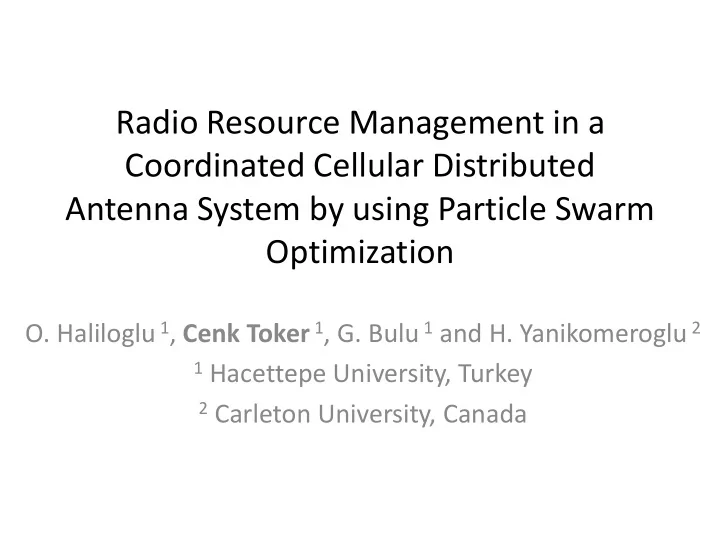

Radio Resource Management in a Coordinated Cellular Distributed Antenna System by using Particle Swarm Optimization O. Haliloglu 1 , Cenk Toker 1 , G. Bulu 1 and H. Yanikomeroglu 2 1 Hacettepe University, Turkey 2 Carleton University, Canada
Contents • Introduction • System Model and Problem Formulation • Previous Work and Motivation • PSO Solution • Simulations and Results Cenk Toker - Hacettepe University 2
Introduction • Frequency reuse factor = 1 → Cell-edge users experience inter-cell interference. Heaped-up users experience intra-cell interference – Solution: Heterogeneous Networks (HetNets) • Apart from macrocells → picocells, femtocells, remote radio heads (ports) • With the introduction of new access point types into the network, conventional interference mitigation techniques are not valid anymore. • New radio resource management (RRM) approaches and algorithms must be developed to optimize the system performance. Cenk Toker - Hacettepe University 3
System Model – CoMP scenario • Scenario: • Multiple ports in a cell (7 ports/cell) • One RB throughout the network • one user served per cell • Inter-Cell Interference (ICI) • Problem formulation: • maximize the worst SINR over the network • Each user must have a guaranteed SINR level. Cenk Toker - Hacettepe University 4
Problem Formulation 2 𝑀 𝑚=1 ∝ 𝑚𝑛 𝑄 𝑚𝑛 ℎ 𝑚𝑛𝑛 𝑥 𝑚𝑛 𝑇𝐽𝑂𝑆 𝑛 (∝, 𝒙) = 2 𝜏 𝑜2 + 𝑜=1,𝑜≠𝑛 𝑁 ∝ 𝑚𝑜 𝑄 𝑚𝑜 ℎ 𝑚𝑜𝑛 𝑥 𝑚𝑜 m : user in the m -th cell P lm : max. Power transmitted from the l -th port antenna in the m -th cell h lmn : channel gain bw. the m-th user and the l -th port in the n-th cell α lm : weight (power) of the l -th port antenna in the m -th cell Problem variables w lm : weight (beamforming) of the l -th port antenna in the m -th cell ∈ 0,1 𝑀𝑁 × ℂ 𝑀𝑁 𝑥 𝑚𝑛 ≜ 𝑓 −𝑘∠ℎ 𝑚𝑛𝑛 , ∀𝑚, 𝑛 𝑛𝑏𝑦 𝑛𝑏𝑦 min 𝑇𝐽𝑂𝑆 𝑛 (∝) min 𝑇𝐽𝑂𝑆 𝑛 (∝) ∝ ∝ ∝ ∈ 0,1 𝑀𝑁 𝑔𝑝𝑠 𝐷𝑄𝑁 ∝ ∈ 0,1 𝑀𝑁 𝑔𝑝𝑠 𝐶𝑄𝑁 𝑡. 𝑢. 𝑡. 𝑢. Cenk Toker - Hacettepe University 5
Previous Work and Motivation • Ahmad, et al.* defined and solved a max-min problem by setting ports on/off (binary power management), i.e. 𝛽 𝑚𝑛 ∈ 0,1 . • Solver used for the problem is Semi-Definite Relaxation (SDR). • We propose to set the port power weight in the range (continuous power management), i.e. 𝛽 𝑚𝑛 ∈ 0,1 • → A nonlinear multimodal optimization problem over ℝ 𝑀𝑁 • We use particle swarm optimization (PSO) to solve the problem. * T. Ahmad, R. H. Gohary, H. Yanikomeroglu, S. Al-Ahmadi, and G . Boudreau, ”Coordinated port selection and beam steering optimization in a multi-cell distributed antenna system using semidefinite relaxation ,” IEEE Trans. Wireless Commun. , vol. 11, no. 5, pp. 1861-1871, May 2012 Cenk Toker - Hacettepe University 6
Particle Swarm Optimization (PSO) • A stochastic evolutionary optimization algorithm Cenk Toker - Hacettepe University 7
Complexity Analysis • Exhaustive search ~ O(2 LM ) (BPM only) • PSO ~ O(SLM) per iteration * N – L: # of ports per cell – M: # of cells – S: population size – N: # of iterations done in PSO BPM CPM 2 cells 53 21 7 cells 97 27 Cenk Toker - Hacettepe University 8
Performance Evaluation • 2-cell & 7-cell clusters with L=7 ports in each cell • Remote radio heads (ports) located uniformly at a distance of 2/3 of the circumradius. • 1 RB throughout the network • At most 1 UE can use this RB in a cell. Cenk Toker - Hacettepe University 9
Two cell cluster Noise limited region Interference limited region Cenk Toker - Hacettepe University 10
Two cell cluster Cenk Toker - Hacettepe University 11
Seven cell cluster Cenk Toker - Hacettepe University 12
Seven cell cluster Cenk Toker - Hacettepe University 13
Conclusion • Instead of employing a single BS per cell, antennas (ports) and transmitted power are distributed to increase the coverage and throughput. • Two transmission schemes: BPM & CPM • CPM outperforms BPM expecially in interference-limited region. • For larger network, CPM performs better than BPM under practically meaningful conditions. • Complexity of CPM is lower than that of BPM. Cenk Toker - Hacettepe University 14
Thank You
Recommend
More recommend